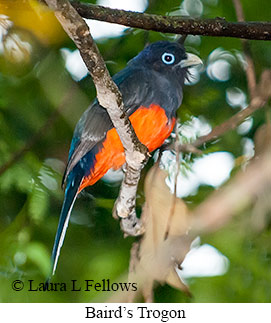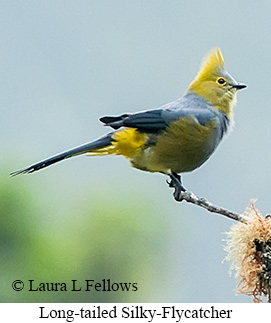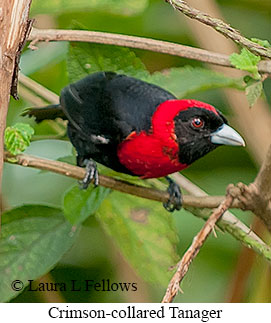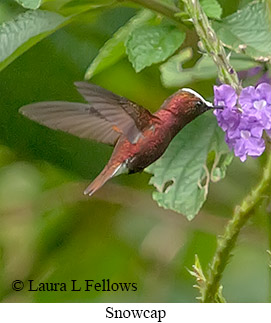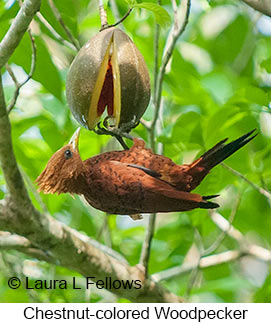CLASSIC HOTSPOTS BIRDING TOUR
Tour Description

COSTA RICA
BIRDING TOUR
ANY TIME*
| Duration: | 9 days, 8 nights |
| Group Size: | 2-8 |
| Anytime Price: | $3675 |
| Group Price: | $3475 |
| Single Suppl: | $200 |
| Est #Species: | 275-325 |
| Pace: | Easy |
| Difficulty: | Easy |
| * This tour is available for any dates of your choosing provided guide services and accommodations are available. | |
DAY 1 - ALAJUELA
International flights arrive in the afternoon or evening. After arrival, transfer to nearby Hotel Aeropuerto, a 5-minute taxi ride from the international airport. Night in Alajuela.
DAY 2 - OROTINA, CEIBA-CASCAJAL ROAD, & CERRO LODGE
Depart early for the Pacific lowlands. The first stop is the central plaza of Orotina where Black-and-white Owls often roost during the day. Then continue to the nearby Ceibo-Cascajal Road, which offers excellent roadside birding through dry forest. The more forested areas are home to Black-headed Trogon, Turquoise-browed Motmot, Long-tailed Manakin, Tropical Royal-Flycatcher, Stub-tailed Spadebill, Nutting's Flycatcher, and Stripe-headed Sparrow. Scrubby areas offer Crested Bobwhite, Striped Cuckoo, the secretive Lesser Ground-Cuckoo, and wintering Grasshopper Sparrow and Painted Bunting. The open fields are home to Double-striped Thick-knee, Southern Lapwing, and Red-breasted Meadowlark. Arrive in time for lunch at Cerro Lodge. Afternoon birding near the lodge and from the veranda overlooking the gardens. The lodge has recently added an observation tower atop a hill, allowing good views at canopy birds. It's a good place for sightings of the uncommon Crane Hawk as well as other raptors such as Hook-billed Kite, Gray-headed Kite, Gray Hawk, Gray-lined Hawk, Short-tailed Hawk, and Bat Falcon. Late in the afternoon Scarlet Macaws usually appear at feeders behind the dining room. Other species sometimes seen on the grounds include Common Ground Dove, Blue-vented Hummingbird, Cinnamon Hummingbird, Black-headed Trogon, Gartered Trogon, White-necked Puffbird, Lineated Woodpecker, Hoffnann's Woodpecker, Orange-chinned Parakeet, Yellow-naped Parrot, Crimson-fronted Parakeet, Rufous-naped Wren, and Streak-backed Oriole. Night at Cerro Lodge.
DAY 3 - CARARA NATIONAL PARK
All day bird Carara National Park. The park is in a transitional zone between northern and southern Pacific coastal areas and attracts a nice combination of northern and southern species. Bird the Laguna Meandrica trail through secondary forest paralleling the Tarcoles River. This trail is wide and fairly level, affording easy walking. Specialties typically seen along the trail include White-whiskered Puffbird, Baird's Trogon, Black-hooded Antshrike, Slaty Antwren, Chestnut-backed Antwren, Orange-collared Manakin, Rufous-naped Wren, Black-bellied Wren, Rufous-and-white Wren, Scarlet-rumped Tanager, and Spot-crowned Euphonia. With luck one could also find Long-tailed Manakin and Rufous-breasted Wren. At the end of the trail are some ponds where roosting Boat-billed Herons are normally present in thick understory near the river. Also present sometimes are Black-bellied Whistling-Ducks. After lunch at the lodge, bird the Headquarters Trail at Carara. This trail goes through primary forest where species composition is quite different. The trail is flat, paved, and easy. Notable species possible include Gray-chested Dove, Bronzy Hermit, White-whiskered Puffbird, Black-hooded Antshrike, Streak-chested Antpitta, Tawny-winged Woodcreeper, Northern Bentbill, Stub-tailed Spadebill, Riverside Wren, Long-billed Gnatwren, Orange-billed Sparrow, and Yellow-throated Euphonia. Night at Cerro Lodge.
DAY 4 - TALAMANCA HIGHLANDS & SAN GERARDO DE DOTA
Depart after early breakfast for San Gerardo de Dota, a highland valley in the Talamanca Mountains. It's a bit more than a 4-hour drive. Enroute stop at Georgina's Restaurant, best location to view Fiery-throated Hummingbird and a good site for Volcano Hummingbird as well. Then drive up the winding road to the top of Cerro de la Muerte, so-named because for a long time people had to travel through these mountains on horseback or on foot to reach San Jose before the road was constructed in the 1950's, and ill-prepared travelers sometimes perished enroute. Birding the road up to the antenna area atop Cerro de la Muerte should produce several high elevation specialties, notably Volcano Hummingbird, Timberline Wren, Peg-billed Finch, Sooty-capped Chlorospingus, Volcano Junco, and Large-footed Finch. We'll stop at a local but quite pleasant restaurant at the road juction that descends into the valley for lunch before continuing down into the vallyey of San Gerardo de Dota and our lodge. After arrival, we'll visit the hummingbird feeders at the lodge, which attract species such as Lesser Violetear, Green-crowned Brilliant, Talamanca Hummingbird, Purple-throated Mountain-gem, White-throated Mountain-gem, Scintillant Hummingbird, Crowned Woodnymph, and Rufous-tailed Hummingbird. Night at Savegre Mountain Lodge.
DAY 5 - PARAISO QUETZALES & SAN GERARDO DE DOTA
Depart early for an excursion to Paraiso Quetzales, where they have a program for getting good views of Resplendent Quetzals on a local finca. Then view hummingbirds coming to feeders near Paraiso Quetzales Lodge. Return to our lodge for lunch. Afternoon drive high up the mountain behind the lodge and bird the trail going back down. It's possible to see Resplendent Quetzal once again, though not reliably so. More importantly, we'll seek other highland species of note such as Spotted Wood-Quail, Ruddy Pigeon, Barred Parakeet, Sulphur-winged Parakeet, Lineated Foliage-gleaner, Streak-breasted Treehunter, Ruddy Treerunner, Mountain Elaenia, Yellow-winged Vireo, Black-faced Solitaire, Black-billed Nightingale-Thrush, Long-tailed Silky-Flycatcher, Black-cheeked Warbler, Wrenthrush, Spangle-cheeked Tanager, Silver-throated Tanager, Peg-billed Finch, and Flame-colored Tanager. Night at Savegre Mountain Hotel.
DAY 6 - RESERVA EL COPAL & QUELITALES
Depart early for Reserva el Copal, located in the highlands southeast of Cartagena, about a 3-hour drive. We'll spend much of the day birding this foothill site on the Caribbean slope of Costa Rica. It's especially good for tanagers, including Flame-colored Tanager, White-winged Tanager, Red-throated Ant-Tanager, Tawny-crested Tanager, Crimson-collared Tanager, Scarlet-rumped Tanager, Speckled Tanager, Golden-hooded Tanager, Spangle-cheeked Tanager, Rufous-winged Tanager, Bay-headed Tanager, Emerald Tanager, and Silver-throated Tanager. Many other forest birds are also present at this site. In late afternoon we'll continue on to our hotel near the town of Quelitales. The hotel grounds have hummingbird feeders and gardens that attract about 70% of all hummingbird species found in Costa Rica (more than 30 species). Night at Hotel Quelitales.
DAY 7 - HOTEL QUELITALES & SARAPIQUI
We'll spend the morning birding the grounds around hotel Quelitales. Key species of interest in addition to humminbirds are Red-headed Barbet, Ochre-breasted Antpitta, Dark Pewee, Slaty-backed Nightingale-Thrush, Sooty-faced Finch, and Cabanis's Ground-Sparrow. This is one of the best places to see the extremely elusive Scaled Antpitta. Afternoon transfer to the Sarapiqui area near Puerto Viejo. Enroute stop near El Tapir Nature Reserve to look for Snowcap and other hummingbirds in the flowering beds and then stop to bird some additional sites along the way before arriving in Puerto Viejo. The main target species at these sites are Canebrake Wren, a split from Plain Wren, and Gray-crowned Yellowthroat. Raptors such as White Hawk, Gray-lined Hawk, and Bat Falcon are also possible. Night at Hotel Ara Ambigua.
DAY 8 - LA SELVA BIOLOGICAL STATION, SELVA VERDE, & TRANSFER
We'll depart very early for nearby La Selva Biological Station, probably birding the entrance road before entering the reserve. Over 400 species have been recorded in this reserve. Access to some trails is restricted for most groups, but we can usually get exceptional access because our guide is Costa Rican and works at La Selva when not guiding groups. In addition to the entrance road, birding is around the clearing near the visitor center and and along an extensive network of trails through primary and secondary forest. It's preferable to bird the forest interior early when bird activity is at its best. Several hundred species are possible and we see different ones on every visit, which is typical when birding in rainforest. Possibilities include Great Tinamou, Semiplumbeous Hawk, Chestnut-colored Woodpecker, Pale-billed Woodpecker, Fasciated Antshrike, Great Antshrike, Black-crowned Antshrike, Black-headed Tody-Flycatcher, Bare-necked Umbrellabird, White-collared Manakin, Crimson-collared Tanager, Golden-hooded Tanager, Dusky-faced Tanager, and many more. If an army ant swarm is encountered, obligate and opportunistic army ant followers such as Bicolored Antbird, Ocellated Antbird, Gray-headed Tanager and Red-throated Ant-Tanager are very possible. At mid-day when birding has slowed substantially, we may drive the short distance to Selva Verde Lodge for lunch if Sunbitterns have been seen recently along the river there. After lunch transfer to Alajuela, about a 3-hour drive with birding stops enroute. Night at Hotel Aeropuerto in Alajuela.
DAY 9 - END OF TOUR
Tour ends with breakfast at the hotel. International flights home.
ADDITIONAL INFO
(Not on Menu Above)
BIRDING LOCALES
